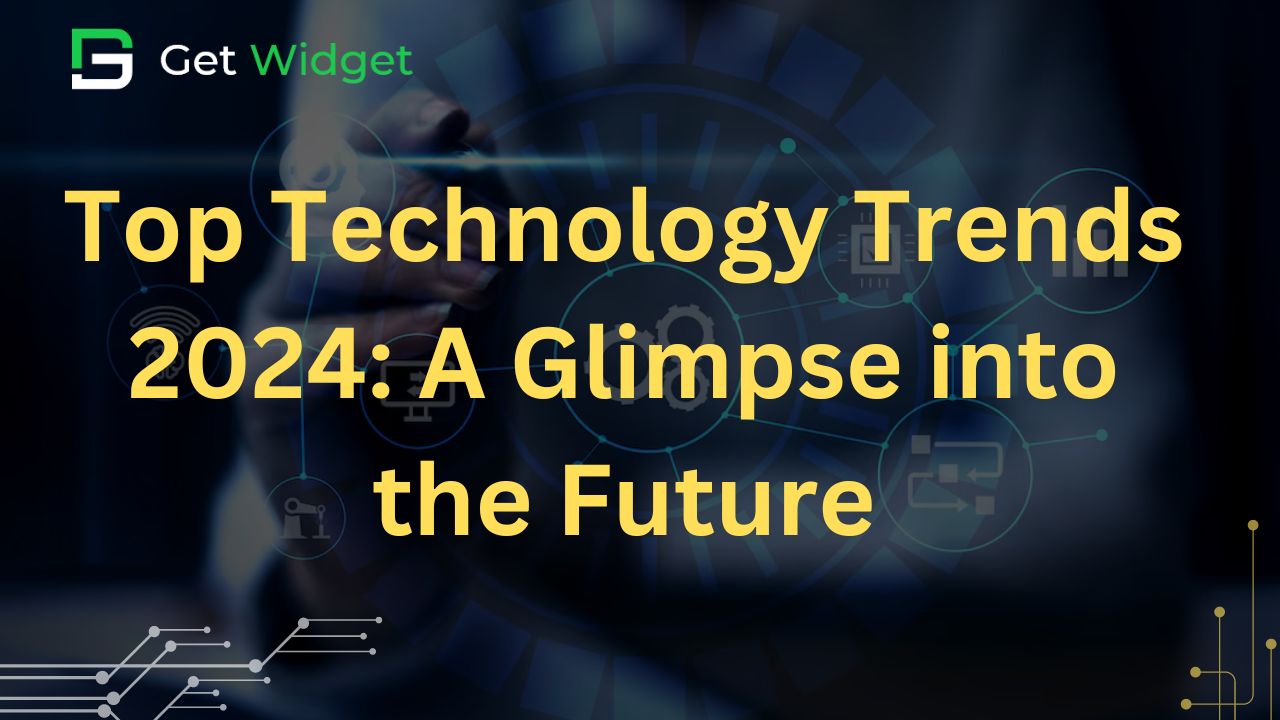In today’s fast-paced digital world, technology is continuously evolving at an unprecedented rate, revolutionizing every aspect of our lives. From artificial intelligence to blockchain, the technological landscape is constantly expanding, bringing forth innovative solutions and disrupting traditional industries. Staying informed and updated with the latest technology trends is more crucial than ever before to remain competitive, adapt to changes, and leverage new opportunities.
Rapid Advancements in Technology:
- Technologies like artificial intelligence, Internet of Things, and 5G are advancing rapidly, transforming how we live, work, and interact.
- Breakthroughs in quantum computing, cybersecurity, and sustainable tech are reshaping the future of various sectors.
- The convergence of different technologies is leading to new possibilities and driving digital transformation across industries.
Importance of Staying Updated:
- Keeping abreast of the latest technology trends allows individuals and businesses to innovate, improve efficiency, and stay ahead of the competition.
- Understanding emerging technologies helps in making informed decisions, implementing relevant solutions, and adapting to changing consumer preferences.
- Embracing new tech trends can lead to enhanced productivity, cost savings, and better user experiences, ensuring long-term success in a dynamic digital environment.
As we delve into the top technology trends of 2024, it becomes evident that staying informed and proactive in embracing innovation is key to unlocking the full potential of technology and driving sustainable growth in the modern era.As a key player in global mobile app development companies, Getwidget has consistently shown curiosity about upcoming trends. Following thorough research across historical, current, and future data, we are highlighting the latest technological trends and patterns that modern businesses should monitor in 2024.
Here are the top 10 significant pursuits for the upcoming year.
1. Artificial Intelligence (AI)
Artificial Intelligence (AI) plays a significant role in various industries and has a profound impact on businesses and society. Here are some key points regarding AI:
Role of AI in various industries:
- AI is being used in industries such as healthcare, finance, manufacturing, retail, and transportation to automate processes, improve efficiency, and enhance decision-making.
- In healthcare, AI is utilized for medical imaging analysis, drug discovery, and personalized medicine.
- In finance, AI algorithms are employed for fraud detection, risk assessment, and algorithmic trading.
- AI is also used in customer service, marketing, and supply chain management across different sectors.
Advancements in AI algorithms and applications:
- AI algorithms have evolved significantly, enabling machines to learn from data, recognize patterns, and make predictions.
- Deep learning, a subset of AI, has revolutionized areas such as computer vision, natural language processing, and speech recognition.
- AI applications have expanded to include virtual assistants, autonomous vehicles, recommendation systems, and smart home devices.
Impact of AI on businesses and society:
- AI has the potential to transform businesses by improving operational efficiency, reducing costs, and enabling innovation.
- AI is highly useful in various industries, including finance, manufacturing, and healthcare software development.
- It can automate repetitive tasks, freeing up human resources to focus on more complex and creative endeavors.
- AI-powered technologies have the potential to address societal challenges, such as healthcare accessibility, environmental sustainability, and urban planning.
- However, the widespread adoption of AI also raises concerns about job displacement, privacy, and ethical considerations that need to be addressed.
Artificial Intelligence is a rapidly evolving field with immense potential to shape the future. Its applications and impact continue to expand, making it crucial for businesses and individuals to stay informed and adapt to the changing technological landscape.
2. Internet of Things (IoT)
The Internet of Things (IoT) has witnessed significant growth in both devices and applications, transforming various industries. Here are key points about IoT:
Growth of IoT devices and applications:
- The number of IoT devices continues to surge, with estimates projecting billions of connected devices by 2024. As per Statists, the number of such devices will be 50 billion by 2023.
- IoT applications span across sectors such as smart homes, healthcare, transportation, agriculture, and industrial automation.
- IoT devices collect and exchange data through sensors, enabling real-time monitoring, predictive analytics, and automation.
Integration of IoT in smart homes, healthcare, and transportation:
- In smart homes, IoT devices like smart thermostats, security cameras, and voice assistants enhance convenience and energy efficiency.
- IoT is revolutionizing healthcare through remote patient monitoring, personalized care, and smart medical devices.
- In transportation, IoT enables fleet management, traffic optimization, autonomous vehicles, and smart infrastructure for enhanced safety and efficiency.
Security and privacy concerns with the proliferation of IoT:
- The rapid growth of IoT raises concerns about data security, privacy breaches, and vulnerability to cyberattacks.
- IoT devices often lack robust security features, making them susceptible to hacking and unauthorized access.
- Ensuring data encryption, secure authentication, and regular software updates are crucial to mitigate IoT security risks and safeguard user privacy.
As IoT continues to expand its reach and influence, addressing security and privacy challenges is paramount to harnessing its full potential for innovation and efficiency across industries. Stay informed about best practices and emerging technologies to navigate the evolving landscape of IoT securely and responsibly.
3. 5G Technology
The deployment of 5G networks is revolutionizing connectivity with enhanced speed and capabilities. Here are important points about 5G technology:
Expansion of 5G networks globally:
- 5G networks are rapidly expanding worldwide, with telecom companies investing in infrastructure to bring high-speed connectivity to more regions.
- Countries across the globe are rolling out 5G networks to support the increasing demand for data-intensive applications and services.
Enhanced connectivity and speed:
- 5G technology offers significantly faster download and upload speeds compared to its predecessors, enabling seamless streaming, faster downloads, and low latency.
- The increased bandwidth and reduced latency of 5G networks support real-time communication, ultra-high-definition video streaming, and immersive experiences like augmented reality (AR) and virtual reality (VR).
Potential applications of 5G in different sectors:
- Healthcare: 5G enables remote patient monitoring, telemedicine services, and surgical procedures conducted by specialists in different locations.
- Manufacturing: In smart factories, 5G facilitates real-time monitoring of equipment, predictive maintenance, and automation of processes for increased efficiency.
- Transportation: 5G supports connected vehicles for improved traffic management, autonomous driving, and vehicle-to-vehicle communication to enhance road safety.
- Retail: Retailers can utilize 5G for personalized shopping experiences, inventory management, and cashier-less stores powered by IoT devices.
- Entertainment: 5G enables high-quality streaming, gaming, and interactive experiences through cloud gaming services and AR/VR applications.
5G technology has the potential to transform various industries by enabling faster, more reliable connectivity and innovative applications. Embracing the capabilities of 5G can lead to enhanced productivity, efficiency, and customer experiences across sectors, paving the way for a future powered by advanced connectivity.
4. Blockchain
Blockchain technology has evolved beyond cryptocurrencies, finding applications in various sectors. Here are key points about blockchain:
Evolution of blockchain technology beyond cryptocurrencies:
- Blockchain technology, known for its decentralized and secure nature, is being adopted for diverse applications beyond cryptocurrencies like Bitcoin.
- Industries are exploring blockchain for its potential to enhance transparency, security, and efficiency in data management and transactions.
- According to Gartner, the global business value generated by blockchain will reach around $3.1 trillion by 2030.
Use cases in supply chain management, finance, and healthcare:
- Supply chain management: Blockchain enables end-to-end supply chain visibility by tracking products at each stage, ensuring authenticity, reducing fraud, and improving traceability.
- Finance: Blockchain streamlines financial transactions, facilitates cross-border payments, enhances security, and enables smart contracts for automated agreements. It is well-suited for applications where trust and security are of utmost importance, such as in the use of financial software development, supply chain management, and voting systems.
- Healthcare: Blockchain secures patient data, ensures interoperability among healthcare providers, and enables transparent sharing of medical records while maintaining patient privacy.
Decentralized finance (DeFi) and its impact:
- Concept of DeFi: DeFi refers to decentralized financial services built on blockchain networks, offering alternatives to traditional finance by eliminating intermediaries and providing open access to financial products.
- Impact of DeFi: DeFi protocols enable users to access lending, borrowing, trading, and other financial services without relying on centralized institutions. This decentralized approach fosters financial inclusion, reduces costs, and empowers individuals to have more control over their assets.
Blockchain’s versatility and security features make it a promising technology for revolutionizing various sectors beyond cryptocurrencies. By leveraging blockchain for supply chain management, finance, healthcare, and exploring the potential of DeFi, organizations can enhance efficiency, transparency, and trust in their operations, paving the way for a more decentralized and secure digital future.
5. Extended Reality (XR)
Extended Reality (XR) represents the convergence of virtual reality (VR), augmented reality (AR), and mixed reality (MR) technologies, offering immersive experiences across various domains. Here’s an overview of XR:
Merge of VR, AR, and MR:
- Virtual Reality (VR): Immerses users in a simulated environment, often used for gaming, training simulations, and virtual tours.
- Augmented Reality (AR): Overlays digital content onto the real world, enhancing experiences in areas like education, marketing, and navigation.
- Mixed Reality (MR): Blends virtual and real-world elements, enabling interactive and dynamic experiences for training, design, and collaboration.
Applications in gaming, education, training, and entertainment:
- Gaming: XR technologies enhance gaming experiences by creating immersive worlds, interactive storytelling, and realistic simulations.
- Education: XR transforms learning by offering interactive lessons, virtual field trips, and hands-on experiences in subjects like science, history, and art.
- Training: XR is used for immersive training simulations in industries such as healthcare, aviation, engineering, and military to enhance skill development.
- Entertainment: XR technologies enable interactive movie experiences, virtual concerts, and immersive storytelling in theme parks and museums.
Future prospects of XR technology:
- Enhanced user experiences: XR will continue to blur the lines between physical and digital worlds, offering more engaging and personalized experiences.
- Industry innovation: XR technologies will drive innovation in sectors like healthcare, architecture, retail, and manufacturing by revolutionizing design, visualization, and customer engagement.
- Collaboration and communication: XR will enable remote collaboration through virtual meetings, shared workspaces, and immersive communication tools, enhancing productivity and connectivity.
As XR technology evolves, its applications will expand across industries, revolutionizing how we interact with digital content and the world around us. The future of XR holds exciting possibilities for creating immersive, interactive, and transformative experiences that redefine how we learn, work, entertain, and connect in the digital age.
6. Cybersecurity Innovations
Cybersecurity is another rapidly evolving sector that totally earns its place in the list of current technology trends in 2024. Cybersecurity plays a crucial role in safeguarding digital assets, privacy, and infrastructure in the increasingly interconnected world. Here’s an overview of cybersecurity innovations:
Importance of cybersecurity in the digital age:
- With the rise of digitalization and interconnected systems, cybersecurity is essential to protect data, networks, and devices from cyber threats.
- Cyberattacks can have severe consequences, including data breaches, financial losses, reputation damage, and disruption of critical services.
New trends in cybersecurity to combat evolving threats:
- Zero Trust Security: Focuses on verifying each user and device accessing the network, regardless of their location, to prevent unauthorized access.
- Cloud Security: Enhances protection for cloud-based data and applications, addressing risks associated with cloud adoption.
- Endpoint Detection and Response (EDR): Monitors endpoint devices for suspicious activities and responds to threats in real-time.
- Identity and Access Management (IAM): Ensures that only authorized individuals have access to specific resources, reducing the risk of insider threats.
- Threat Intelligence: Utilizes data analysis to proactively identify and mitigate potential threats before they cause harm.
Role of AI and machine learning in enhancing cybersecurity measures:
- AI-driven Threat Detection: AI algorithms analyze vast amounts of data to detect anomalies and patterns indicative of cyber threats.
- Behavioral Analysis: Machine learning models can identify unusual behavior within networks or systems, flagging potential security incidents.
- Automated Response: AI-powered systems can respond to security incidents rapidly, mitigating threats and reducing response times.
- Predictive Analytics: Machine learning algorithms can forecast potential security risks based on historical data, enabling proactive security measures.
By leveraging AI and machine learning technologies, organizations can strengthen their cybersecurity posture, detect threats more effectively, and respond to incidents in real-time. These innovations play a vital role in staying ahead of evolving cyber threats and ensuring the resilience of digital systems and data in today’s complex threat landscape.
7. Quantum Computing
Quantum computing represents a paradigm shift in data processing, offering immense potential to revolutionize various industries. The global quantum computing market is projected to grow by $1765 million by 2025. Here’s an overview of breakthroughs, potential, challenges, and opportunities in the field of quantum computing:
Breakthroughs in quantum computing research:
- Quantum Supremacy: Achieving quantum supremacy, where a quantum computer outperforms classical supercomputers in certain tasks, was a significant milestone.
- Error Correction: Advances in error correction codes and fault-tolerant quantum computing are crucial for building reliable quantum systems.
- Quantum Algorithms: The development of quantum algorithms, such as Shor’s algorithm for integer factorization and Grover’s algorithm for unstructured search, showcase the power of quantum computation.
The potential of quantum computing to revolutionize data processing:
- Exponential Speedup: Quantum computers have the potential to solve complex problems exponentially faster than classical computers, impacting fields like cryptography, optimization, and material science.
- Parallel Processing: Quantum systems can perform parallel computations due to quantum superposition and entanglement, enabling rapid data processing and analysis.
- Optimization: Quantum computing can optimize complex systems and processes more efficiently, leading to advancements in logistics, finance, drug discovery, and more.
Challenges and opportunities in the field of quantum computing:
- Hardware Limitations: Building scalable and stable quantum hardware remains a challenge due to decoherence, noise, and error rates.
- Algorithm Development: Designing quantum algorithms that leverage the unique properties of quantum systems requires expertise and innovation.
- Skills Gap: There is a shortage of skilled professionals in quantum computing, highlighting the need for education and training programs.
- Security Implications: Quantum computing poses security risks to current cryptographic systems, prompting the need for quantum-resistant encryption methods.
Despite challenges, quantum computing offers unprecedented opportunities for innovation, discovery, and problem-solving. As research progresses and technologies mature, quantum computing is poised to transform industries, drive scientific breakthroughs, and reshape the future of data processing and computation.
8. Sustainable Technology
Sustainable technology solutions are becoming increasingly prevalent as organizations and individuals prioritize environmental conservation and reduce their carbon footprint. Here’s an overview of the rise of eco-friendly technology solutions, sustainable practices in tech, and the impact on the environment:
The rise of eco-friendly technology solutions:
- Renewable Energy: The adoption of renewable energy sources, such as solar and wind power, to power data centers, devices, and operations.
- Energy-Efficient Devices: Development of energy-efficient devices, appliances, and systems that minimize power consumption and reduce greenhouse gas emissions.
- Green Data Centers: Implementation of energy-efficient cooling systems, server virtualization, and renewable energy sources in data center operations.
- Circular Economy: Embracing circular economy principles to reduce electronic waste through recycling, refurbishment, and responsible disposal of tech products.
Sustainable practices in tech manufacturing and operations:
- Materials Recycling: Incorporating recycled materials in product manufacturing to reduce resource consumption and minimize environmental impact.
- Energy Management: Implementing energy management systems and practices to optimize energy usage, reduce carbon emissions, and lower operational costs.
- Carbon Offsetting: Investing in carbon offset programs to counterbalance carbon emissions generated during manufacturing, transportation, and operations.
- Supply Chain Sustainability: Collaborating with suppliers to ensure ethical sourcing practices, reduce waste, and promote sustainability throughout the supply chain. As a result, 50% of CIOs are planning to implement performance metrics as part of the IT sustainability strategy.
Impact of sustainable technology on the environment:
- Carbon Footprint Reduction: Sustainable technology solutions help lower carbon emissions, mitigate climate change, and contribute to a greener future.
- Resource Conservation: By promoting energy efficiency and recycling, sustainable technology conserves resources, reduces waste, and minimizes environmental degradation.
- Ecosystem Preservation: Sustainable practices support biodiversity conservation, protect natural habitats, and promote ecological balance.
- Public Health: Reduced pollution and environmental impact from sustainable technology positively impact public health by improving air and water quality.
Overall, the adoption of sustainable technology solutions not only benefits the environment by reducing carbon emissions and resource consumption but also promotes innovation, efficiency, and responsible stewardship of natural resources for a more sustainable future. Therefore, it stands out as one of the innovative technology trends poised to ascend in 2024 and beyond.
9. Datafication
In 2024, datafication emerges as a prominent technology trend capable of transforming intricate enterprise operations into measurable data points, offering precise, data-driven insights. Datafication refers to the process of transforming various aspects of life and business activities into data.
Here are some key points about datafication:
Definition: Datafication involves the conversion of analog information into digital data that can be collected, analyzed, and utilized for decision-making and insights.
Scope: It extends beyond traditional data sources to include a wide range of activities, interactions, and processes that generate data in the digital age.
Examples:
Internet of Things (IoT): Sensors embedded in devices collect data on usage patterns, performance metrics, and environmental conditions.
Social Media: User interactions, preferences, and behaviors on social platforms generate vast amounts of data for analysis.
E-commerce: Purchase history, browsing behavior, and transaction data provide insights into consumer preferences and trends.
Benefits:
Informed Decision-Making: Datafication enables organizations to make data-driven decisions based on real-time insights and analytics.
Personalization: By analyzing data, businesses can offer personalized experiences, products, and services to customers.
Efficiency: Data-driven processes improve operational efficiency, optimize resource allocation, and enhance productivity.
Challenges:
Privacy Concerns: Datafication raises privacy issues related to data collection, storage, and usage, leading to concerns about data security and protection.
Data Quality: Ensuring data accuracy, relevance, and integrity is crucial for deriving meaningful insights and avoiding biases.
Regulatory Compliance: Adhering to data protection laws and regulations, such as GDPR, requires organizations to manage data responsibly.
Future Trends:
Artificial Intelligence: AI and machine learning technologies will play a key role in analyzing and extracting value from large datasets.
Ethical Data Use: Emphasizing ethical principles in data collection, processing, and sharing will be essential for building trust and transparency.
Data Monetization: Organizations will explore new ways to monetize data assets while balancing economic benefits with ethical considerations.
Datafication continues to shape how businesses, governments, and individuals interact with information, driving innovation, insights, and challenges in the evolving data landscape.
10. Super App Development
Super App Development refers to the creation of multifunctional applications that offer a wide range of services and features within a single platform. These apps aim to provide users with a seamless and integrated experience by combining various services such as messaging, payments, shopping, transportation, home services app, grocery ordering app, food delivery app, and more into a single app. Super apps have gained popularity due to their convenience, efficiency, and ability to meet multiple needs of users in one place. Companies investing in super app development are focused on creating comprehensive solutions that cater to various aspects of users’ daily lives, making it easier for them to access different services through a single application. Given the forecast that more than 50% of the global population will engage with multiple super apps, this industry undoubtedly falls within the scope of upcoming technology trends.
Conclusion
Embracing technological advancements is crucial in today’s rapidly evolving world. As we witness the rise of innovations like super app development and generative AI, it becomes increasingly important for individuals and organizations to stay informed and adapt to the changing tech landscape. By embracing these advancements, we can harness the power of technology to enhance our lives, drive progress, and shape the future. Stay curious, stay informed, and be ready to embrace the opportunities that the ever-changing tech world presents.
FAQ
1. What are the top 5 trending technologies?
Here are the top 5 technology trends gaining recognition among developers and enterprises as of 2023:
- Artificial Intelligence (AI)
- Internet of Things (IoT)
- Blockchain
- Cloud Computing
- 5G Technology
2. What are the future technology trends for 2024?
Here are some future technology trends for 2024:
- Generative AI: Artificial intelligence systems that can generate new content and ideas.
- Computing Power: Advancements in processing power that enable faster and more complex computations.
- Smart(er) Devices: Devices that are more intelligent and capable of interacting with their environment.
- Datafication: The increasing use of data and analytics to drive decision-making and innovation.
- Spatial Computing: The integration of virtual and augmented reality into everyday experiences.
These trends indicate a future where technology becomes more human-centric, intelligent, and interconnected.





